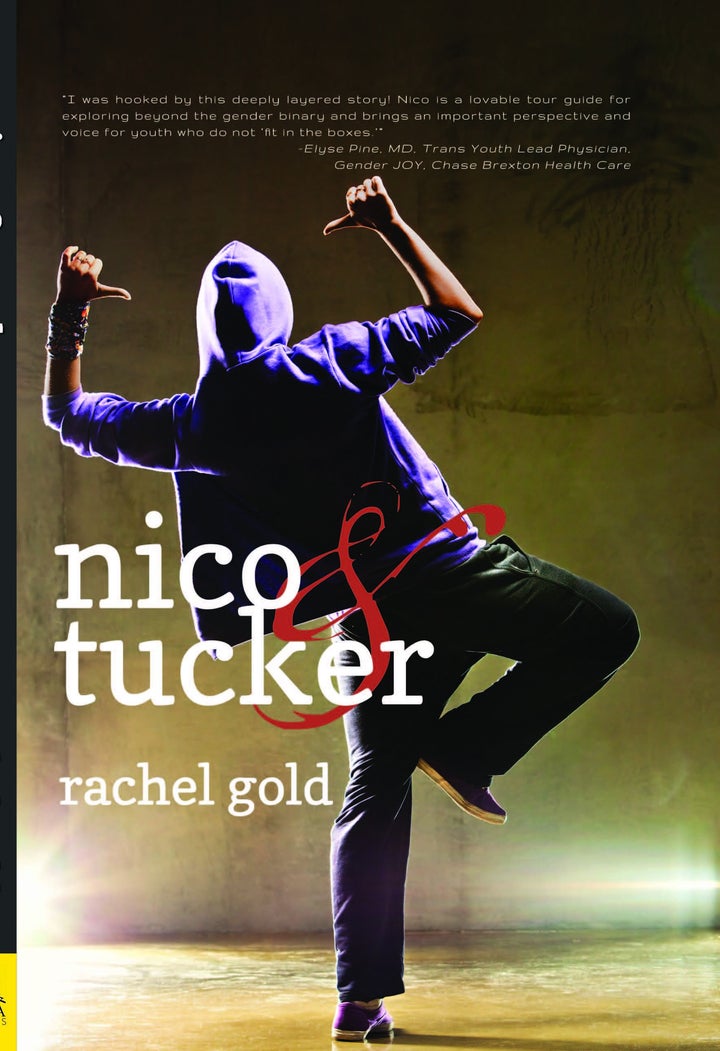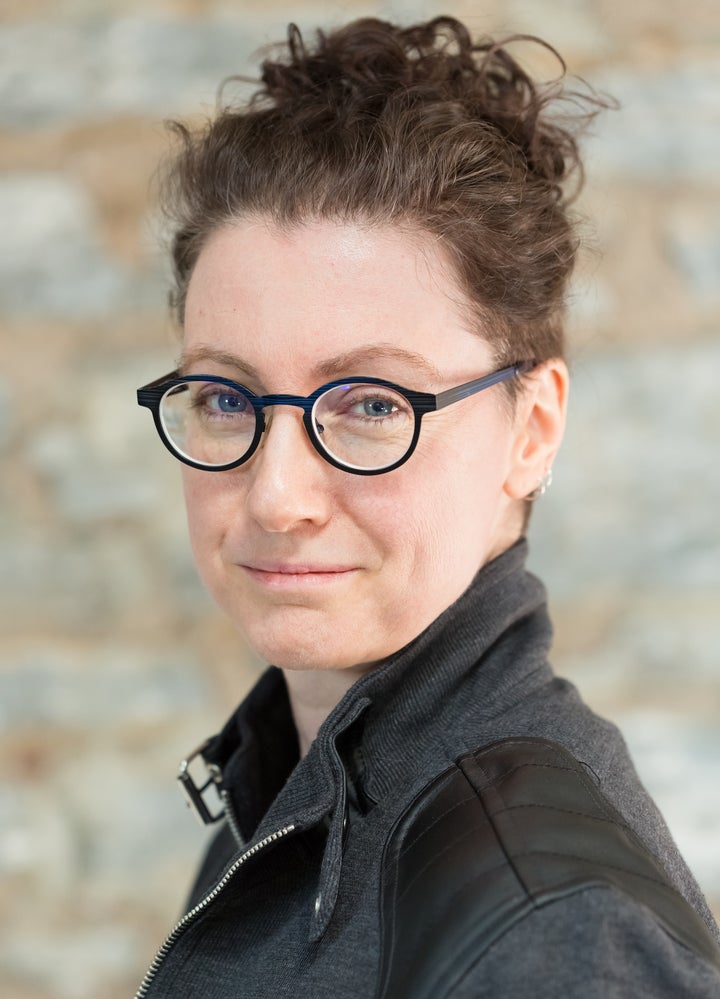Rachel Gold is the award-winning author of multiple YA novels with queer and trans characters, including Being Emily, the first young adult novel to tell the story of a trans girl from her perspective. Gold, who describes herself as a geek and a gamer, has an MFA in creative writing. It was a pleasure to get a chance to talk with her about her insightful and touching new book, Nico & Tucker, featuring a character who considers yoself (preferred pronoun) nonbinary, neither male nor female. It will be available May 16, 2017.

What exactly does it mean to be nonbinary, and how is it different from being trans?
Let’s start with gender: this is a way that we categorize people’s bodies. But most people don’t think of gender as a category, just as a reality. It’s like if you go to the border between the U.S. and Canada, there’s no natural line. The landscape itself doesn’t differentiate between the U.S. and Canada, but people do. American and Canadian are real categories that have a lot of real-world consequences.
The landscape of the human body also has no clear line where people fit neatly on one side or another. And different cultures draw gender lines in different ways to explain the diversity of human biology. I’ve read about cultures with up to six different genders. American culture has tended to have two: woman and man. That’s the binary: when you’re born you get one of two options assigned to you.
One definition of trans is that you identify with the other gender from what you were assigned at birth. The doctor said, “It’s a boy!” and you identify as a girl, or vice versa.
One way to describe nonbinary is that you don’t feel that you fit either the woman or man category. Maybe you feel like part of both, or all of both, or some of each and something else – or the whole idea of gender doesn’t make sense to you. There are a lot of ways to describe nonbinary, so please be open to people’s descriptions.
Are nonbinary people also trans?
Trans is now often used as a broad term for anyone whose gender identity does not match the gender they were assigned at birth. So it includes people transitioning across the binary male-to-female or female-to-male – and there are trans people who identify as nonbinary, agender, genderfluid and other outside-the-binary identities.
Your book also includes people born with intersex traits. Where does intersex fit?
Culturally we act like woman and man are really clear cut and based in biology, but that’s not how nature operates. Male and female occur on a spectrum. If a person’s body is physically close to the middle of that spectrum, they’re said to have intersex traits. A person might have ambiguous genitals or maybe the doctor says “boy” because that’s how they look at birth, but they later discover that they have ovaries. Or they’re assigned “girl” at birth but have XY genes.
There are a lot of different variations and historically many tragic outcomes when doctors forced kids to conform to a gender category without their consent. For more info, see InterACT Advocates.
Is being nonbinary always connected to physical intersex indicators, like Nico?
No, not at all. Most of the time people with intersex traits feel like they’re women or men. I chose to have the character of Nico in Nico & Tucker be a nonbinary person with intersex traits because that really opened up showing so many layers of gender and biology that make up human beings.
According to the science I’ve read, you’re more likely to identify as nonbinary because of your brain than your body. This points to gender being processed mainly in the brain. I’m not saying gender is created by the brain. I haven’t seen anything that definitively points to where gender is created, but my money’s on a complex interplay of brain, body, culture and consciousness.
You can be born with ambiguous genitals and still be completely clear that you’re a man or a woman. But higher numbers of people with neurodiverse brains identify as nonbinary, trans or gender variant. For example, there are studies now showing that gender variance can be a lot higher among kids with ADHD and kids on the Autism Spectrum than for neurotypical kids. A study in 2014 found that, “participants with ASD were 7.59 times more likely to express gender variance; participants with ADHD were 6.64 times more likely to express gender variance.”
Your signature block includes your preferred pronouns. Do you see a time when that will be standard for everyone? What pronouns should we use for someone who is trans or non-binary?
I’m seeing it more and more often. I just gave a speech at my alma mater (go Macalester!) and the program flow had each person’s pronoun next to their name. Some events also include a space for your pronouns on your nametag or offer buttons with pronouns on them.
One of the best ways to ask for someone’s pronoun is to introduce yourself by giving your own pronoun. Don’t assume someone knows what yours is.
Some of your characters are into cosplay. What is that and how does it relate to gender presentation?
Cosplay is dressing up as characters from fiction/media, usually at conventions or other events. Large science fiction/fantasy conventions will have some very elaborate cosplay and competitions, such as teams of people dressing up as the cast of an entire show.
When I was a teen, before the invention of the term “cosplay,” my friends and I dressed up as characters from a fantasy book series. I got to make up a character that included both female and male elements (and a dragon!). So to my mind, cosplay has always been a great way to explore gender expressions playfully.
Plus most of the time when I’m going to something more formal, I feel that dressing as a woman is costume for me. This actually makes it easier for me to know what to wear.
How does being mixed race relate to the character’s ideas about being both or in between?
The family Nico lives with is very blended and also very safe, which makes it easier to Nico to self-express. Nico’s mom is half black and half Thai and a professor of astrophysics at Ohio State University, so all of those come together in how she raised Nico.
Her experiences dealing with racism helped her know how to advocate for Nico as a kid with intersex traits. The time she’s spent in Thai culture made her more open to the idea of three or more genders. And being an astrophysicist, she’s very grounded in the diversity and wonder of the universe.

Our own culture is increasingly accepting of non-gender-conforming presentation and behavior. So, if men can wear eye-liner and women can have buzz-cuts, why be non-binary?
Let’s go back to my analogy and say you’re a person from the U.S. but you’re spending the summer in Canada and you happen to look French Canadian. You know a smidge of French, but everyone is talking to you in fluent French and expecting you to understand them. You go back to your apartment and get your “USA” t-shirt. Now people start asking in French how your trip to the USA was.
From the time I was a kid, people have expected me to speak and understand fluent “woman.” I can get by in “woman” – I know enough to ask where the bathroom is – but I’m not fluent. Having a buzz cut can be like putting on the “USA” t-shirt in that people think I’m fluent in woman and have taken some trips to other locations. They don’t realize that I grew up in another country and I’m not understanding half of what they’re saying to me.
One of my favorite lines in the book is: "Being around someone where I couldn’t make assumptions made me realize all the times I was on autopilot.” Does that relate to more than just LGBTQIA issues?
Absolutely! In many ways, autopilot is a feature of privilege. So for example if I’m a white person in a group of white people and no one’s questioning what we’re missing because we don’t have any people of color participating – that’s autopilot. Or if a group isn’t questioning if their space is physically or economically accessible to all the people who might want to participate, that’s autopilot.
That moment when you hit up against your own autopilot is very rich. We all have these opportunities to take our brains off autopilot and expand the world we know.
